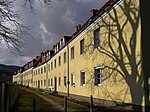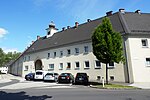Hitler buildings
The residential buildings in Linz that were planned or built during the time of National Socialism are referred to as Hitler buildings . Especially in the districts of Bindermichl , Spallerhof and Urfahr , but also in other parts of the city, numerous "Hitler buildings" were built. This term is also common in other Upper Austrian cities for residential buildings from the Nazi era, for example in Steyr ( Münichholz district ).
history
Housing construction is a result of the industrial settlement in Linz during the Nazi era ( Reichswerke Hermann Göring , nitrogen works, etc.), which exacerbated the housing shortage that had existed since the interwar period. The population of Linz rose from 112,000 in 1938 to almost 200,000 in 1945. 11,000 new apartments were built at the same time. Forced laborers and prisoners of war were also used for the construction work and the material was produced in the Mauthausen concentration camp and sub-camps .
Large inner courtyards with green areas are typical of the Hitler buildings. In addition to the large blocks of flats for the workers, which are architecturally classified according to the Heimatschutz style based on the shape of Upper Austrian square courtyards, single and multi-family houses for executives, officers etc. were also built in settlements. The unfinished or war-damaged buildings were completed after the war.
The general planning was largely the responsibility of the architect Roderich Fick . The buildings were carried out by various planners such as Armin Sturmberger , Fritz Fanta , Herbert Rimpl and Hans Arndt as well as by Roderich Fick himself. Some of these buildings are listed.
Settlements
Linz
| photo | Construction year | Surname | Location | description | Metadata |
|---|---|---|---|---|---|

|
1942 | Aubergsiedlung |
Pfeifferstrasse 12–20, Landgutstrasse 33–35, Nißlstrasse 13–15, 14, Am Teich 2–30, 27–31 location |
Architect: Fritz Fanta |
|

|
1940-1941 | Auhofsiedlung |
Aubrunnerweg 1–43, Altenberger Straße 50–56 Location |
Former Auhof infantry barracks, architect: Roderich Fick |
|

|
1940-1943 | Bachlfeldsiedlung |
In Bachlfeld 22–38c, Keplerstrasse 22–36 location |
Architects: Bruno Biehler (Im Bachlfeld), Heinrich Rettig (Keplerstraße) |
|

|
1940-1945 | Bindermichlsiedlung |
Entire district, bounded by the streets Hanuschstrasse / Ramsauerstrasse / Am Grubbichl / Mörikeweg location |
Architect: Herbert Rimpl |
|

|
1940 | Froschbergsiedlung |
Whole district, bounded by the streets Ziegeleistraße / Roseggerstraße / Regerstraße / Kudlichstraße / Johann-Strauss-Straße location |
Architects: Armin Sturmberger , Herbert Rimpl , Philipp Holzmann , Mauriz Balzarek |
|

|
1940 | Gründbergsiedlung |
Am Anger, Am Alten Feldweg, In der Stockwiesen, In der Scheibenwiesen, In Lackerwiesen, Blindwiesen location |
Architect: Roderich Fick , parts are under monument protection |
|
| 1938-1941 | Guglsiedlung |
Roseggerstrasse 17–23, 35–39, Schiedermayrweg 6–8, 7–17 location |
Architect: Hans Kampfer , Hans Feichtlbauer |
|
|

|
1940-1942 |
Harbach settlement |
Leonfeldner Strasse 66–130 and 99–107c location |
"Führersiedlung", architect: Roderich Fick , is a listed building |
|

|
1941 | Hartmayr settlement |
Leonfeldner Strasse, Linke Brückenstrasse, Am Hartmaygut, Peuerbachstrasse, Heilhamer Strasse, Prager Strasse location |
Architect: Roderich Fick |
|

|
Kaplanhofsiedlung |
Entire district, bounded by the streets Lederergasse / Gruberstrasse / Körnerstrasse / Holzstrasse location |
Architects: Fabigan & Feichtinger, Schrade, Walter Brossmann , Herbert Soche , Eugen Wachberger , Josef Ertl |
|
|

|
Karlhofsiedlung |
limited by the streets Leonfeldner Straße / Weigunystraße / Marianweg / Hölderlinstraße location |
Architects: Fritz Fanta , Eduard Dittrich |
|
|

|
1939 | Keferfeldsiedlung |
entire district, bounded by the streets Losensteinerstraße / Hummelhofstraße / Preglstraße / Gruentalerstraße / Landwiedstraße / Meggauerstraße / Schaunbergerstraße Location |
Architect: Herbert Rimpl |
|

|
1939 |
Makartviertel |
Makartstrasse, Lissagasse, Wiener Strasse, Richard-Wagner-Strasse location |
Architect: Herbert Rimpl |
|

|
1943 | Rothenhofsiedlung |
Leonfeldner Strasse 57–69, Hauserstrasse 1–11, Merianweg, Kubinweg location |
Architect: Roderich Fick |
|

|
1941 | Schorgenhub settlement |
entire district "Neue Heimat", bounded by the streets Dauphinestrasse / Siemensstrasse / Rohrmayrstrasse / Flötzerweg location |
Architect: Fritz Norkauer |
|

|
1940 | Kleinmünchen settlement |
entire district, bounded by the streets Dauphinestraße / Wiener Straße / Wimmerstraße / Dürerstraße / Simonystraße Location |
Architects: Hans Arndt , Herbert Rimpl |
|

|
Spallerhofsiedlung |
entire district, bounded by the streets Muldenstrasse / Müller-Guttenbrunn-Strasse / Scheibenpogenstrasse / Zinöggerweg location |
|
Leonding
| photo | Construction year | Surname | Location | description | Metadata |
|---|---|---|---|---|---|

|
Flak settlement |
In the flak settlement, Welser Straße 23–33 location |
|
Steyr
| photo | Construction year | Surname | Location | description | Metadata |
|---|---|---|---|---|---|

|
1938-1944 | Münichholzsiedlung |
Entire district, bounded by the Enns and the streets Leo-Gabler-Strasse / Erwin-Puschmann-Strasse / August-Hilber-Strasse / Schumannstrasse / Johann-Prinz-Strasse / Otto-Pensel-Strasse / Dr.-Alfred-Klar-Strasse Location |
Architect: Herbert Rimpl |
|
literature
- Sylvia Necker , Elisabeth Kramer: “Hitler Buildings” in Linz. Housing estates between everyday life and history. 1938 to the present. Published by the museums of the city of Linz. Salzburg 2012, ISBN 978-3-7025-0679-7 .
- Günter Kaar, Manfred Carrington , Andreas Reiter: LiNZ contemporary history - from the provincial to the steel city, living and everyday life. Lentia-Verlag, Linz 2012, ISBN 978-3-9503469-1-6 .
- Paul Mahringer: Dealing with the structural legacy of the Nazi era in Linz. Polyvalence and transformation of uncomfortable monuments. Dissertation University of Vienna 2012. ( digitized )
- Sylvia Necker: Living (ge) histories 1938–2013. 75 years of WAG. Published by WAG , Linz 2013. ( digitized )
- Helmut Retzl , Günter Rammerstorfer: Steyr-Münichholz - model settlement, broken glass district, future model. Ennsthaler, Steyr 2018, ISBN 978-3-85068-991-5 .
Web links
- Housing for the "national community". In: ORF.at, September 21, 2012.
- "HITLER BUILDINGS" IN LINZ. Housing estates between everyday life and history. 1938 to the present. September 21, 2012 to January 20, 2013. In: Nordico Stadtmuseum Linz, archive.
- Nazi buildings in Froschberg. In: stadtgeschichte.linz.at.
- Bibliography on Hitler buildings in the forum OoeGeschichte.at.
Individual evidence
- ↑ a b "Hitler Buildings" in Linz. Housing estates between everyday life and history. 1938 to the present. Exhibition in the NORDICO City Museum Linz. September 21, 2012 to January 20, 2013 in the forum OoeGeschichte.at.
- ^ City of Linz, monuments
- ^ City of Linz, monuments
- ^ City of Linz, monuments
- ^ City of Linz, monuments
- ^ City of Linz, monuments
- ^ City of Linz, monuments
- ^ City of Linz, monuments
- ^ City of Linz, monuments
- ^ City of Linz, monuments
- ^ City of Linz, monuments
- ^ City of Linz, monuments
- ^ City of Linz, monuments
- ^ City of Linz, monuments
- ^ City of Linz, monuments
- ^ City of Linz, monuments
- ^ City of Linz, monuments
- ^ City of Linz, monuments
- ^ City of Linz, monuments
- ^ City of Linz, monuments
- ^ Raimund Locicnik : Münichholz: 4500 apartments were planned. Upper Austrian News , October 2, 2013.
